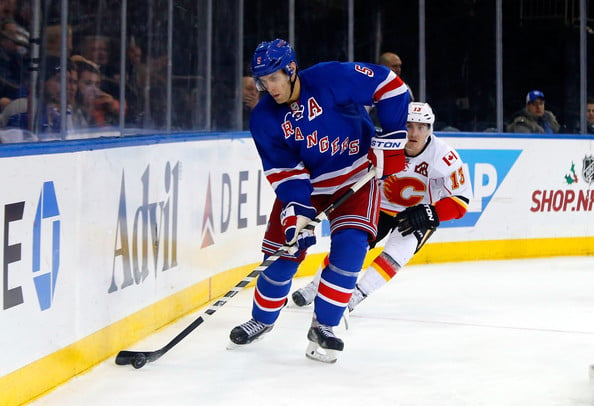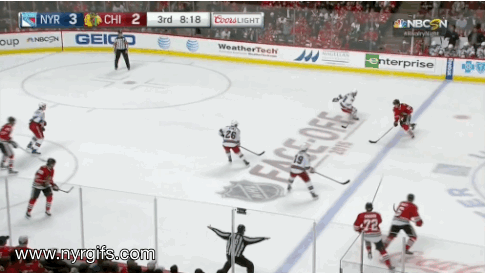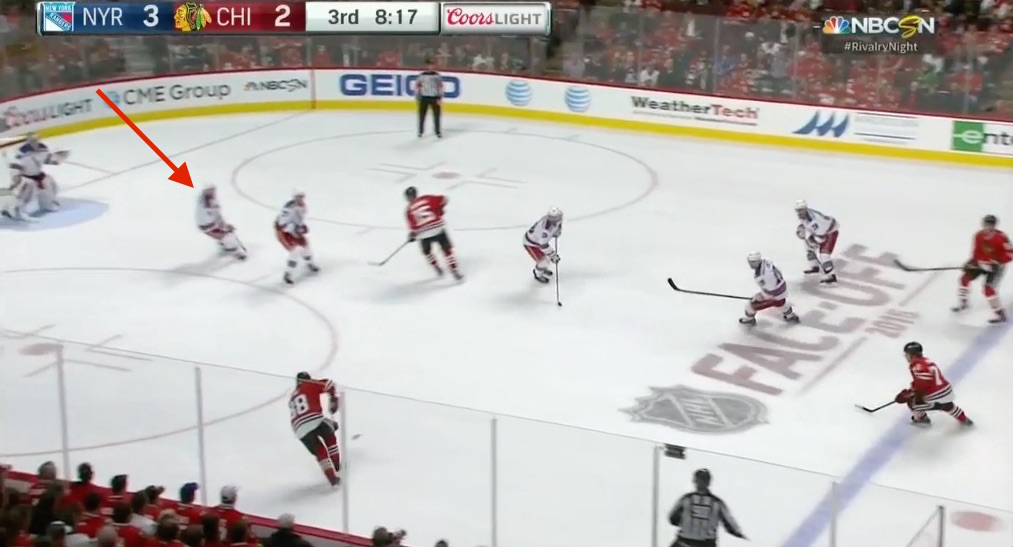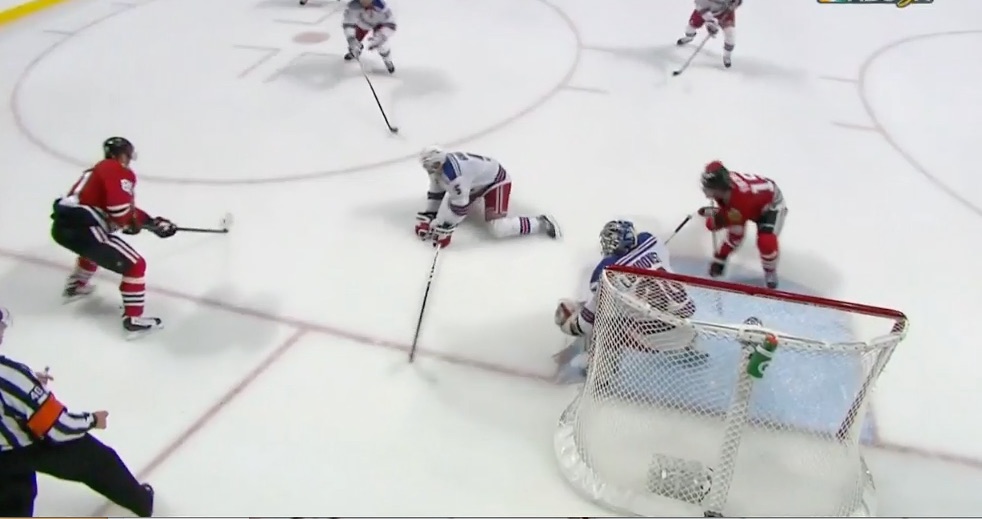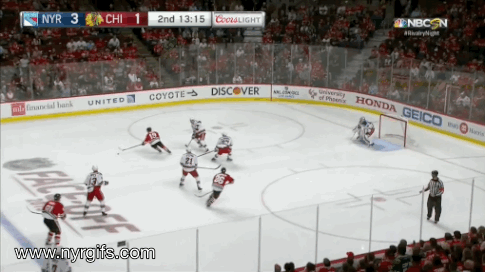Dan Girardi is probably the most interesting Ranger on the roster. He is the subject of a very vocal amount of criticism that is only equaled by the vocal amount of praise. It’s an age-old battle of “watch the game nerd” versus “#fancystats.” Here’s the dirty little secret of the eye-test and #fancystats: If you’re only using one, you’re doing it wrong. We’ve all seen what the numbers say on Girardi, it’s been discussed ad nauseam around these parts. Suffice it to say, they are not favorable.
The disconnect is tying those numbers his play in the defensive zone. And in the defensive zone, system matters. There is a major difference between John Tortorella’s low-zone collapse and Alain Vigneault’s overload/man coverage hybrid (shift to man coverage when the puck is below the goal line). In a low-zone collapse the goal is to defend the high risk areas and block shots. This requires that all players be proficient at blocking shots –which is a skill, no doubt– and understanding when to block the shot and when to let your goalie make the save.
In an overload, the goal is to outnumber the opposition on the wall and create pressure on the puck carrier. When the puck is below the goal line, players switch from an overload to man coverage. Everyone is always moving, and the scheme is a difficult transition from a collapsing team. Those 9-2 and 6-0 losses on the west coast two seasons ago are constant reminders. This kind of system is incredibly reliant on quick skaters and gap control.
What’s Been Going Wrong
And this brings us back to Girardi. His strength is in blocking shots, it’s why Torts leaned so heavily on him during his tenure. There’s no denying this. But when it comes to AV’s system it’s been a difficult transition, one that Girardi is still trying to make. Let’s look at three plays in the season opener. The first is where Patrick Kane was able to get a decent scoring chance on a clean look with room:
This is the right side of the ice, so it’s Girardi’s territory and Kane is Girardi’s man. Here’s the freeze frame where Girardi is caught following the puck:
Girardi recovers here, takes out Kane’s cut to the inside, and forces the shot from the faceoff dot. But Girardi should be cognizant of Kane on the ice, and this is too much room to give someone like Kane.
Here’s the disputed no goal, when Girardi’s job is to cut off the passing lane between Marian Hossa at the goal line and Jonathan Toews at the crease. He gets a little help from Toews here, but Girardi drops to his patented “snow angel” and does not prevent the pass from getting through.
In this instance, the Rangers were lucky that the “intent to blow” rule worked out in their favor here.
We see this happen a lot in the wrong matchups. Speed guys that can burn to the outside catch Girardi on his heels regularly. The Triplets murdered Girardi in the Eastern Conference Final last year. Guys like Kane and Toews also do this regularly.
Girardi’s ability to push the puck up the ice has been questioned almost hourly. In this same Chicago game, he had a pretty rough shift that led to the Teuvo Teravainen goal. I put the full gif below.
If you watch the play, Girardi chases Toews to the top of the circle, way out of position and way too high. Girardi then goes further out to Toews, cuts off his pass to two Hawks behind him, then goes to the boards to recover the puck. Girardi then tries to shuffle the puck up the boards to Hayes, but Toews blocks it. Girardi is now completely out of position with two Hawks behind him. Toews moves the puck to Hossa, who gets it to Teravainen for the goal. This was a pretty brutal shift, but really illustrates some of the poor puck decisions he’s made.
What’s Been Going Right
As much as the critics, myself included, try to blame Girardi for everything, there are specific plays that he’s made that we need to see more of. In AV’s system, the goal for a defenseman is not one-dimensional. In addition to sticking his man, he needs to use accurate gap control, force turnovers, and then move the puck up the ice. When I say move the puck up the ice, I don’t mean the stretch pass (here’s a nice one to Kevin Hayes from the other night.). I mean the short, smart pass to start the transition up the ice and smoothly exit the zone. This is an example from the Chicago game:
Girardi bumps Hossa off the puck, gathers the biscuit, then makes a quick backhand pass to Derek Stepan. This starts a series of short passes that leads to a zone exit. It’s the quick pass that cuts off a Chicago offensive zone rush and turns the play the other way. These are the passes we need to see from Girardi. And quite frankly, we don’t see it enough for a top pairing defenseman.
A note about this kind of pass: This is the pass that shows up in the Corsi/Fenwick stat, but not on the overall stat sheet for goals/assists. This is a crucial, tiny play that often gets overlooked. It’s what makes Anton Stralman so good in his own zone. It shows up in the stat because it maintains puck possession, limits shots against, and pushes the play up the ice for scoring chances.
The other aspect that we expect to see from Girardi is solid gap control. During Tuesday night’s loss, Girardi stood up to a Winnipeg rush in the neutral zone, forcing a broken zone entry and taking the puck carrier out of the play.
The gif cuts off after, but you’ll probably notice a 2-on-1 developing. That’s on the backcheck, not Girardi.
Winnipeg isn’t the fastest team in the league, so this kind of gap control is much easier for Girardi. He had similar successes against Columbus. But the fast teams, like Chicago, burned him. Girardi excels when he’s not up against burners, and against guys that like to cut to the middle of the ice. Alex Ovechkin is a prime example here. He cuts to the middle, which is why Girardi has some success on him (as much as anyone can really have on him). Sidney Crosby is another guy that cuts to the middle.
Conclusion
Let’s make the obvious one first. The critics are way too harsh and the supporters refuse to admit any fault in his game. There’s a balance here, and we are all guilty of this. Girardi isn’t the worst defenseman in the league, but he’s also not the best shutdown defenseman in the league. He’s a defenseman with strengths and weaknesses, and one that smart coaches can exploit regularly if he has the correct personnel.
Girardi excels at limiting quality attempts against teams that don’t have burners down the wing. He can keep these guys to the outside. Very rare is the occasion when someone successfully makes a crossover from the boards to the high slot for a high quality chance. They happen, like when Boone Jenner deked Girardi so bad he slid 50 feet, but they aren’t that often.
Where Girardi falters, and where he gets exploited the most, is against quick teams that gain speed in the neutral zone and then fly down the boards. These guys simply go around Girardi, since he doesn’t have the foot speed to keep up or prevent them from going around him. The Triplets are a prime example here. The problem here is that the league is moving towards speed/skill, and very few teams are big and hulking. Other than Winnipeg, Boston and LA come to mind.
Girardi’s other main issue, one that shows up in the #fancystats, is that he is not a good puck mover. More often than not, he’s pinned in his own end, unable to transition the play up the ice. He’s not Paul Coffey, he’s not going to make that huge breakout pass regularly. What we want is the little pass to start the transition up the ice. It is what is expected of him, especially after he forces a turnover in the defensive zone. We need more of that, and we haven’t gotten it.
These conclusions aren’t observations from a four game start to the season. It is something that has been noticed over the past two seasons and has progressively gotten worse. But from it comes the major point I’m trying to make.
Dan Girardi needs the right system to succeed. That system is one that limits opportunities to exploit his weaknesses while maximizing those strengths. I don’t believe Girardi is the right guy to be a shutdown defenseman in AV’s system because he lacks two main components that AV needs: speed and quick passing. That is completely different under Torts, who preached shot blocking.
Systems matter when it comes to defensemen, and it’s something that requires significantly more analysis than what has been performed to date. It goes beyond old-school versus new-school. It’s about combining the schools and maximizing the strengths of the players on the ice.
Share:
More About:Players

